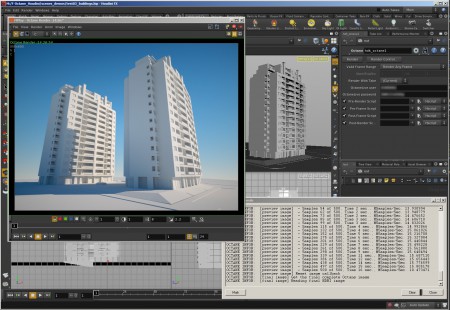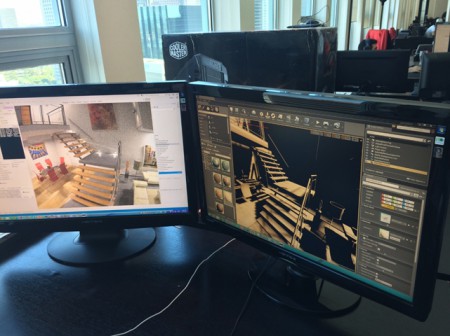OTOY has some of the biggest most exciting announcements this year at SIGGRAPH 2014. We have already written about their exciting X.IO App Streaming service here (check it out) but in addition the company also has announced new expansive OctaneRender integration with numerous third-party software tools.
Epic Integration
Now OctaneRender is getting integrated with more popular 3D applications, including The Foundry’s NUKE compositing software, Side Effects Software’s Houdini 3D animation software, Autodesk’s MotionBuilder 3D character animation software, and Epic Games’ Unreal Engine 4.
Following the unveiling this week of holographic video, a groundbreaking new media format for immersive, photorealistic content, OTOY also revealed further details of the content pipeline that will allow artists, animators, designers and engineers to capture, create, publish, and display their own holographic videos by harnessing light field rendering technology in OctaneRender™ Cloud Edition in the months to come.

01 – OctaneRender inside Houdini, one of many programs on target to have OctaneRender plugin support. (image courtesy of OTOY. All rights reserved).
OTOY also revealed new means of applying the same holographic light field data within 3D engines such as Unreal, physical simulation engines such as Pixelux’s Digital Molecular Matter (DMM) Engine, and audio engines to simplify design of games and other interactive applications while improving realism. OTOY demonstrated both OctaneRender and ORBX holographic video this week at the annual international conference on computer graphics, SIGGRAPH 2014.
Remarkable Innovation
“OTOY has achieved the impossible task of simplifying the complex science of true-to-life rendering down to a series of mouse clicks,” said Vik Sohal, co-founder of Pixelux. “With the integration of Pixelux’s Digital Molecular Matter Engine into OctaneRender Cloud Edition, we’re providing the same intuitive simplicity to finite-element-based destruction, letting content creators apply the intricate math behind the material properties and object interactions that make up the real world without needing to be simulation experts themselves.”
MORE: Why OTOY will change our 3D world: A conversation with Jules Urbach
“Working with a growing list of exceptional partners, OTOY continues to make OctaneRender more accessible to content creators everywhere while adding functionality,” said Jules Urbach, Founder and CEO, OTOY. “Holographic video is an exceedingly elegant format that simplifies the production and sharing of incredible 3D experiences while holographic light field data opens the door to extraordinarily sophisticated, yet easy to implement simulations of physics and audio, and streamlined game and 3D application development. OTOY’s holographic video pipeline is flexible not only for how it allows content creators to work, but also for the myriad of options content creators will have in harnessing holographic data to make their work easier.”
Extending the Value of Holographic Data through OctaneRender Cloud Edition
OctaneRender is well regarded for its simplicity and ease-of-use, taking advanced material rendering concepts that typically require knowledge of shader programming, and transforming photorealistic scene-building to a simple point-and-click exercise using OctaneRender™’s efficient node graph.
OTOY is now bringing that simplicity to other advanced simulation elements in 3D, including physics, audio and other 3D engines. This will come in the upcoming OctaneRender™ Cloud Edition, harnessing the holographic data for faster, more accurate simulations. In bullet outline:
- Improving destruction simulations — Pixelux’s acclaimed DMM Engine is the physical simulation engine that will be integrated into OctaneRender™ Cloud Edition, giving content creators access to the same advanced technology used to create high-end destruction simulations for major motion pictures. With the integration, content creators will have an easy means of applying real-world physical simulation to their scenes without worrying about performance limits. Using DMM’s incredible ability to allow the simulation of complex structures bending and breaking made of anything from diamond to jelly, content creators will be able to create the visual reality to match their imagination all through advanced simulation.
- Improving audio simulations — Audio has always been a challenge for interactive 3D scenes, particularly for VR experiences that are wholly immersive. Using holographic data within OctaneRender™ Cloud Edition, complex acoustic simulations can be made to match a rendered scene perfectly, including the way audio bounces off of objects in a scene much the way light does. Combined with DMM, audio associated with the collision, bending, tearing, and fracture of objects within a scene can also be easily simulated.
- Supporting other 3D engines — For game development or the production of interactive environments for design, architecture, and attractions, other 3D rendering engines may be desired rather than OctaneRender™’s. OTOY’s cloud-based, real-time photorealistic 3D engine, Brigade, and Epic’s Unreal Engine will be supported, allowing for holographic data to be used as environment maps simplifying things such as collision detection.
The company also is explaining building out its holographic video pipeline bringing several technologies into an end-to-end seamless workflow. OTOY’s LightStage™ marks the first step in creating true-to-life holographic videos, capable of creating true to life “digital doubles.” Users will be able to capture real-world objects using LightStage, import them into OctaneRender stand-alone software or an OctaneRender plugin based 3D application from which they can create a static, non-holographic ORBX file.

02 – Unreal Engine 4 with OctaneRender integration inside via plugin support. (image courtesy of OTOY, all rights reserved.)
Users can then export the static .ORBX scene file to an interactive holographic video using the new OctaneRender Cloud Edition which will support one-click exporting to holographic video. For those looking to enable movement within a scene, OctaneRender™ Cloud Edition will also export to Brigade. Virtual reality head-mounted displays such as the Oculus Rift will also be supported, allowing holographic videos to be exported and immediately viewed.
OctaneRender™ Cloud Edition and the .ORBX holographic video player are both currently in closed betas and will be released to content creators later this year. Integration of Pixelux’s DMM Engine will also be available on OctaneRender™ Cloud Edition at that time. OctaneRender™ plugins for Photoshop, After Effects, NUKE, Houdini, MotionBuilder, and Unreal Engine 4 will be available this year. For more information, or to become a part of the OctaneRender™ and holographic video ecosystem, contact OTOY at [email protected].



Reader Comments
RT @architosh: SIG: OTOY expands OctaneRender integration with NUKE, Houdini, MotionBuilder, Unreal Engine 4 and more: OT… http://t.co/Gx…
RT @architosh: SIG: OTOY expands OctaneRender integration with NUKE, Houdini, MotionBuilder, Unreal Engine 4 and more: OT… http://t.co/Gx…
Comments are closed.